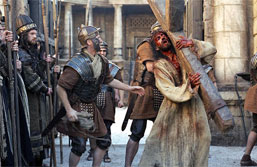
| HOME |
| NERVE |
| REVIEWS |
| ARCHIVE |
| EVENTS |
| LINKS |
| ABOUT US |
| CONTRIBUTORS |
| BACK ISSUES |
| CONTACT US |
 The
Passion of the Christ (18)
The
Passion of the Christ (18)
Dir: Mel Gibson
Screening at Odeon from 26th March 2004
Review by Lesley Fraser
This film takes its audience through the final twelve hours of Jesus’ life; Jim Caviezel realistically acts out the betrayal, arrest, interrogation, scourging and crucifixion in graphic detail. Gibson shows Jesus’ suffering as typical in the times of the Roman justice system since crucifixion and scourging were well used words. There is a brutal flogging scene where 117 lashes are pitilessly administered taking up a massive 26 minutes of the film and this is followed by a horrific and agonising death by crucifixion.
There is no question that this film was extremely difficult to watch. Gibson’s interpretation of Jesus’ suffering is disturbing to say the least due to the sheer brutality of the torture he experienced throughout. There are flashback scenes in the film where we get to see parts of Jesus’ life as both a child and teacher and this might have made it more difficult to watch for some parts of the audience since we get a glimpse of what kind of man he was and what he looked like before his bloody and tortured image is relentlessly flashed across the screen.
Whilst not deviating from the text of the Gospels, certain camera shots appear to give the mother of Jesus a very prominent role, in line with the Catholic tradition. The film also spent an incredible amount of time on the road to Calvary, which perhaps detracts from the spiritual suffering of Jesus.
Criticisms aside, it was a refreshing change from previous Jesus films – with their big 70s hair, bad make-up and American accents. Here, Gibson pays great attention to the costumes, make-up, location and even the Hebrew and Aramaic languages since the whole film is subtitled. Apart from Monica Belluci, the actors are not from the big screen so we got to see some brilliant acting never seen in a Jesus film before!
It is a compelling and disturbing film, which has already provoked strong reactions on all sides, which will no doubt be highlighted over the Easter period. I strongly encourage people to go and see it since it really does provoke a new way of looking at this type of film.